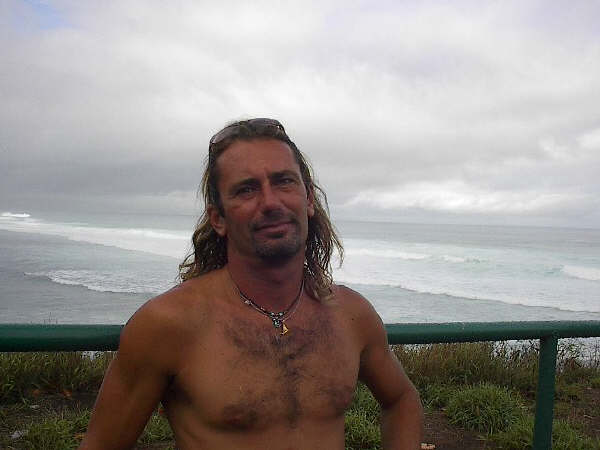I was even lazy enough not to go get the camera in the car and so I have to pull another photo from this wonderful gallery by Si Crowther again. Just one more, this is my favorite one. That is a hell of a long tunnel of water.

4am significant buoy readings
South shore
Lanai
0.8ft @ 18s from 205° (SSW)
Barbers
1ft @ 20s from 188° (S)
As expected, today we have long period southerly energy at the buoys.
In this little collage below I put the weather maps of last Tuesday Dec 27 and the three days after that. We can assume that the 27th was the day in which the first long period waves of this swell were generated for the following two reasons:
1) in the map of the 26th, the fetch is south of New Zealand and hence completely blocked by it
2) even though the fetch seems so far away to suggest at least 8 days of travel, the intensity of the wind was strong enough to generate very long period waves. The period of those waves kept increasing during their travel and as a result the forerunners registered at the local buoys yesterday were in the 20s range. The longer the period, the faster the waves travel, so that explains how they made it all the way up to us in "just" 7 days. Had the wind been a bit weaker, we would have probably needed to wait until tomorrow to see the arrival of the swell and the period would have been less than 18s.
As any distantly generated swell, the arrival of the sets will be very slow because the sets have plenty time (7 days!) to separate from each other. Unless they all have exactly the same period, in fact, they will all travel at a slightly different speed (a 17.9 seconds set will travel slower than a 18.1 seconds one) and even though the speed difference might seem almost unnoticeable, during a 7 long days trip, that amounts to a fairly noticeable physical distance.
Also, at the very beginning of the swell, there's pretty much only the long period waves generated towards the head of the fetch (let's say 18s for example). Already the day after, there will be a mix of the slower sets generated at the head of the fetch (17 or 16s, for example) and the faster sets (18s) generated back at the tail of the fetch. That mix will make for a higher frequency of arrival.
Whenever the buoys only show one period number, you have to think that in the water it's never black or white like that and there will always be a mix of slightly different periods (and directions and sizes). This also explains the 20s at Barbers vs the 18s at Lanai. It's the same exact swell, it's just that the first buoy registered more energy in the 20s range and the second one in the 18s range. In other words, the difference is buoy related not swell related.
Back to our collage, last Tuesday seems the best day of wave generation for me, but there were waves made for at least three more days. But even if there was only one day of wave generation, the swell would last more than one day because of reason explained above: long travel means bigger spacing between sets. It's like the area covered by the swell enlarges while the swell travels. That means waves for the whole week on the south shore, we'll check size and period at the buoys (and webcams!) each single day.

North shore
NW101
3.3ft @ 12s from 333° (NNW)
N
2.8ft @ 12s from 310° (WNW)
0.7ft @ 18s from 338° (NNW)
NW001
4.1ft @ 11s from 356° (N)
NW001
4.1ft @ 11s from 356° (N)
Waimea
2.1ft @ 12s from 336° (NNW)
Current wind map shows:2.1ft @ 12s from 336° (NNW)
0.4ft @ 20s from 287° (WNW)
Pauwela
Pauwela
4ft @ 10s from 14° (NNE)
2.6ft @ 12s from 335° (NNW)
Pretty confusing numbers at the northerly buoys, let's try to understand what's going on. First I'd like to comment on the "short" NNE energy that has been blessing us for many days. It's not at the N buoy anymore, but it's the only one that shows at the NW001 buoy. Strange, but it is a sign that is winding down. In Maui at 5am it's still a solid 4f 10s from 14, so in the early morning will still be here.
On top of that, today we have a small reinforcement from the NW. Remember those fetches confined in the Kamchatka corner by the blocking high pressure? If not, scroll down and check the wind maps, but that's what this energy is. It shows as 12s at all the buoys, so you can tell it's nothing major, but it's something. As I said, today is should be a relatively small day for the north shore, but far from flat.
Also, N and Waimea shows small reading of long period NW energy. Don't get fixated on the weird directions, it's another buoy related thing, not swell related. Poor buoys, they went for "the bible" to "blame the buoys"... They're small and distantly generated and they won't affect the action today much.
In the end, as usual, what counts is what's in the water in Maui and the Pauwela buoy does and excellent job at telling us that. I won't be able to post an Hookipa beach report, because I'm busy teaching on the south shore and I'll leave in the dark, but I guess it will still be head high out there.
One more curiosity. For sure a glitch, but I had to report that the Hanalei buoy registers the longest period I have ever seen at a buoy: 0.1ft @ 28s from 38° (NE).
On top of that, today we have a small reinforcement from the NW. Remember those fetches confined in the Kamchatka corner by the blocking high pressure? If not, scroll down and check the wind maps, but that's what this energy is. It shows as 12s at all the buoys, so you can tell it's nothing major, but it's something. As I said, today is should be a relatively small day for the north shore, but far from flat.
Also, N and Waimea shows small reading of long period NW energy. Don't get fixated on the weird directions, it's another buoy related thing, not swell related. Poor buoys, they went for "the bible" to "blame the buoys"... They're small and distantly generated and they won't affect the action today much.
In the end, as usual, what counts is what's in the water in Maui and the Pauwela buoy does and excellent job at telling us that. I won't be able to post an Hookipa beach report, because I'm busy teaching on the south shore and I'll leave in the dark, but I guess it will still be head high out there.
One more curiosity. For sure a glitch, but I had to report that the Hanalei buoy registers the longest period I have ever seen at a buoy: 0.1ft @ 28s from 38° (NE).
1-2) couple of weak WNW fetches associated with a couple of small lows
3) N fetch responsible for the swell that will hit tomorrow
4) NE fetch keep supplying stead energy from the NE
5) most of this energy generated by this fetch is going to be blocked New Zealand. Only the southernmost corner might eventually manage to send us something...
6) ...but fortunately there's this other guy that is unblocked. South swell also next week, as I already announced yesterday.

Here's an "old school" weather map. What you see above in the brilliant Windity graphical representation (if you go on the original website link n.2, it's even animated) is nothing else that how the air circulates around Highs and Lows on this map below. A bunch of small lows all scattered around the north Pacific is one of my favorite pressure configurations. No huge swells, but plenty waves nonetheless and no sign of trades. Rain or shine, that's winter weather and I absolutely love it.

Just to confirm what I was talking about, the NAM3km map at noon shows little to no wind. For the sake of precise reporting, I need to point out that yesterday a few slogging windsurfers were seen at Kanaha and even up the coast. Robby Naish and Miki were testing windsurfing foils. Perfect wind for that.

Sorry about the eventual mistakes, I got no time to correct the river of words I wrote. I'll eventually do that later also because I labeled this post as "why is the start of south swell so painfully slow", so that it will be easy to access in the future.









No comments:
Post a Comment